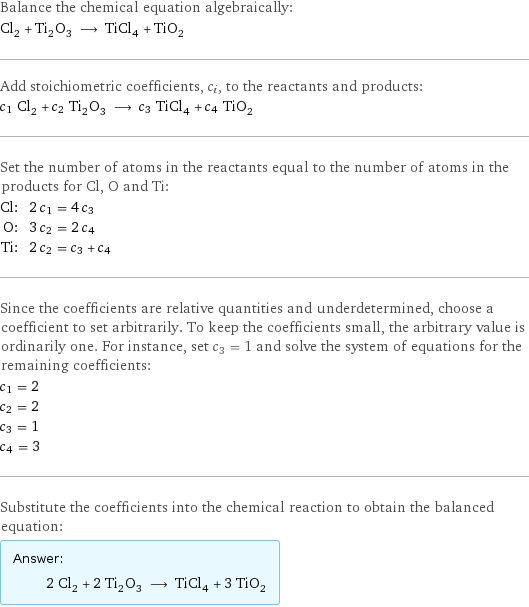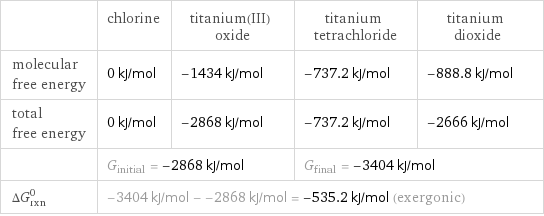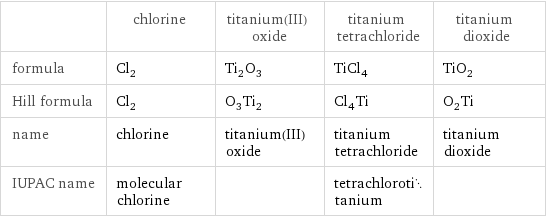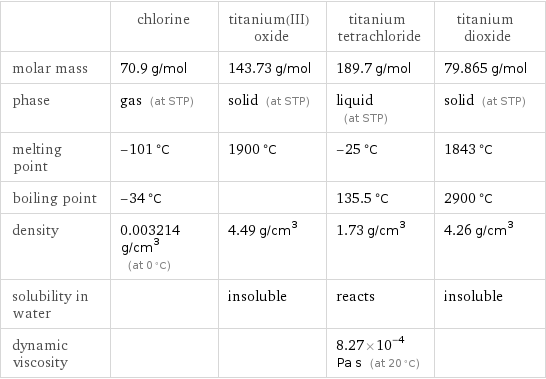Input interpretation

Cl_2 chlorine + Ti_2O_3 titanium(III) oxide ⟶ TiCl_4 titanium tetrachloride + TiO_2 titanium dioxide
Balanced equation

Balance the chemical equation algebraically: Cl_2 + Ti_2O_3 ⟶ TiCl_4 + TiO_2 Add stoichiometric coefficients, c_i, to the reactants and products: c_1 Cl_2 + c_2 Ti_2O_3 ⟶ c_3 TiCl_4 + c_4 TiO_2 Set the number of atoms in the reactants equal to the number of atoms in the products for Cl, O and Ti: Cl: | 2 c_1 = 4 c_3 O: | 3 c_2 = 2 c_4 Ti: | 2 c_2 = c_3 + c_4 Since the coefficients are relative quantities and underdetermined, choose a coefficient to set arbitrarily. To keep the coefficients small, the arbitrary value is ordinarily one. For instance, set c_3 = 1 and solve the system of equations for the remaining coefficients: c_1 = 2 c_2 = 2 c_3 = 1 c_4 = 3 Substitute the coefficients into the chemical reaction to obtain the balanced equation: Answer: | | 2 Cl_2 + 2 Ti_2O_3 ⟶ TiCl_4 + 3 TiO_2
Structures

+ ⟶ +
Names

chlorine + titanium(III) oxide ⟶ titanium tetrachloride + titanium dioxide
Reaction thermodynamics
Gibbs free energy

| chlorine | titanium(III) oxide | titanium tetrachloride | titanium dioxide molecular free energy | 0 kJ/mol | -1434 kJ/mol | -737.2 kJ/mol | -888.8 kJ/mol total free energy | 0 kJ/mol | -2868 kJ/mol | -737.2 kJ/mol | -2666 kJ/mol | G_initial = -2868 kJ/mol | | G_final = -3404 kJ/mol | ΔG_rxn^0 | -3404 kJ/mol - -2868 kJ/mol = -535.2 kJ/mol (exergonic) | | |
Equilibrium constant
![Construct the equilibrium constant, K, expression for: Cl_2 + Ti_2O_3 ⟶ TiCl_4 + TiO_2 Plan: • Balance the chemical equation. • Determine the stoichiometric numbers. • Assemble the activity expression for each chemical species. • Use the activity expressions to build the equilibrium constant expression. Write the balanced chemical equation: 2 Cl_2 + 2 Ti_2O_3 ⟶ TiCl_4 + 3 TiO_2 Assign stoichiometric numbers, ν_i, using the stoichiometric coefficients, c_i, from the balanced chemical equation in the following manner: ν_i = -c_i for reactants and ν_i = c_i for products: chemical species | c_i | ν_i Cl_2 | 2 | -2 Ti_2O_3 | 2 | -2 TiCl_4 | 1 | 1 TiO_2 | 3 | 3 Assemble the activity expressions accounting for the state of matter and ν_i: chemical species | c_i | ν_i | activity expression Cl_2 | 2 | -2 | ([Cl2])^(-2) Ti_2O_3 | 2 | -2 | ([Ti2O3])^(-2) TiCl_4 | 1 | 1 | [TiCl4] TiO_2 | 3 | 3 | ([TiO2])^3 The equilibrium constant symbol in the concentration basis is: K_c Mulitply the activity expressions to arrive at the K_c expression: Answer: | | K_c = ([Cl2])^(-2) ([Ti2O3])^(-2) [TiCl4] ([TiO2])^3 = ([TiCl4] ([TiO2])^3)/(([Cl2])^2 ([Ti2O3])^2)](../image_source/58b33e6aed6a5401b25fed854cd2ced4.png)
Construct the equilibrium constant, K, expression for: Cl_2 + Ti_2O_3 ⟶ TiCl_4 + TiO_2 Plan: • Balance the chemical equation. • Determine the stoichiometric numbers. • Assemble the activity expression for each chemical species. • Use the activity expressions to build the equilibrium constant expression. Write the balanced chemical equation: 2 Cl_2 + 2 Ti_2O_3 ⟶ TiCl_4 + 3 TiO_2 Assign stoichiometric numbers, ν_i, using the stoichiometric coefficients, c_i, from the balanced chemical equation in the following manner: ν_i = -c_i for reactants and ν_i = c_i for products: chemical species | c_i | ν_i Cl_2 | 2 | -2 Ti_2O_3 | 2 | -2 TiCl_4 | 1 | 1 TiO_2 | 3 | 3 Assemble the activity expressions accounting for the state of matter and ν_i: chemical species | c_i | ν_i | activity expression Cl_2 | 2 | -2 | ([Cl2])^(-2) Ti_2O_3 | 2 | -2 | ([Ti2O3])^(-2) TiCl_4 | 1 | 1 | [TiCl4] TiO_2 | 3 | 3 | ([TiO2])^3 The equilibrium constant symbol in the concentration basis is: K_c Mulitply the activity expressions to arrive at the K_c expression: Answer: | | K_c = ([Cl2])^(-2) ([Ti2O3])^(-2) [TiCl4] ([TiO2])^3 = ([TiCl4] ([TiO2])^3)/(([Cl2])^2 ([Ti2O3])^2)
Rate of reaction
![Construct the rate of reaction expression for: Cl_2 + Ti_2O_3 ⟶ TiCl_4 + TiO_2 Plan: • Balance the chemical equation. • Determine the stoichiometric numbers. • Assemble the rate term for each chemical species. • Write the rate of reaction expression. Write the balanced chemical equation: 2 Cl_2 + 2 Ti_2O_3 ⟶ TiCl_4 + 3 TiO_2 Assign stoichiometric numbers, ν_i, using the stoichiometric coefficients, c_i, from the balanced chemical equation in the following manner: ν_i = -c_i for reactants and ν_i = c_i for products: chemical species | c_i | ν_i Cl_2 | 2 | -2 Ti_2O_3 | 2 | -2 TiCl_4 | 1 | 1 TiO_2 | 3 | 3 The rate term for each chemical species, B_i, is 1/ν_i(Δ[B_i])/(Δt) where [B_i] is the amount concentration and t is time: chemical species | c_i | ν_i | rate term Cl_2 | 2 | -2 | -1/2 (Δ[Cl2])/(Δt) Ti_2O_3 | 2 | -2 | -1/2 (Δ[Ti2O3])/(Δt) TiCl_4 | 1 | 1 | (Δ[TiCl4])/(Δt) TiO_2 | 3 | 3 | 1/3 (Δ[TiO2])/(Δt) (for infinitesimal rate of change, replace Δ with d) Set the rate terms equal to each other to arrive at the rate expression: Answer: | | rate = -1/2 (Δ[Cl2])/(Δt) = -1/2 (Δ[Ti2O3])/(Δt) = (Δ[TiCl4])/(Δt) = 1/3 (Δ[TiO2])/(Δt) (assuming constant volume and no accumulation of intermediates or side products)](../image_source/1e653e9b3764ef8f866c882f1b30378a.png)
Construct the rate of reaction expression for: Cl_2 + Ti_2O_3 ⟶ TiCl_4 + TiO_2 Plan: • Balance the chemical equation. • Determine the stoichiometric numbers. • Assemble the rate term for each chemical species. • Write the rate of reaction expression. Write the balanced chemical equation: 2 Cl_2 + 2 Ti_2O_3 ⟶ TiCl_4 + 3 TiO_2 Assign stoichiometric numbers, ν_i, using the stoichiometric coefficients, c_i, from the balanced chemical equation in the following manner: ν_i = -c_i for reactants and ν_i = c_i for products: chemical species | c_i | ν_i Cl_2 | 2 | -2 Ti_2O_3 | 2 | -2 TiCl_4 | 1 | 1 TiO_2 | 3 | 3 The rate term for each chemical species, B_i, is 1/ν_i(Δ[B_i])/(Δt) where [B_i] is the amount concentration and t is time: chemical species | c_i | ν_i | rate term Cl_2 | 2 | -2 | -1/2 (Δ[Cl2])/(Δt) Ti_2O_3 | 2 | -2 | -1/2 (Δ[Ti2O3])/(Δt) TiCl_4 | 1 | 1 | (Δ[TiCl4])/(Δt) TiO_2 | 3 | 3 | 1/3 (Δ[TiO2])/(Δt) (for infinitesimal rate of change, replace Δ with d) Set the rate terms equal to each other to arrive at the rate expression: Answer: | | rate = -1/2 (Δ[Cl2])/(Δt) = -1/2 (Δ[Ti2O3])/(Δt) = (Δ[TiCl4])/(Δt) = 1/3 (Δ[TiO2])/(Δt) (assuming constant volume and no accumulation of intermediates or side products)
Chemical names and formulas

| chlorine | titanium(III) oxide | titanium tetrachloride | titanium dioxide formula | Cl_2 | Ti_2O_3 | TiCl_4 | TiO_2 Hill formula | Cl_2 | O_3Ti_2 | Cl_4Ti | O_2Ti name | chlorine | titanium(III) oxide | titanium tetrachloride | titanium dioxide IUPAC name | molecular chlorine | | tetrachlorotitanium |
Substance properties

| chlorine | titanium(III) oxide | titanium tetrachloride | titanium dioxide molar mass | 70.9 g/mol | 143.73 g/mol | 189.7 g/mol | 79.865 g/mol phase | gas (at STP) | solid (at STP) | liquid (at STP) | solid (at STP) melting point | -101 °C | 1900 °C | -25 °C | 1843 °C boiling point | -34 °C | | 135.5 °C | 2900 °C density | 0.003214 g/cm^3 (at 0 °C) | 4.49 g/cm^3 | 1.73 g/cm^3 | 4.26 g/cm^3 solubility in water | | insoluble | reacts | insoluble dynamic viscosity | | | 8.27×10^-4 Pa s (at 20 °C) |
Units
